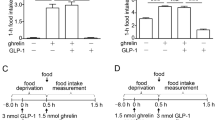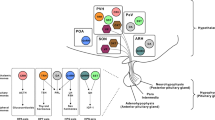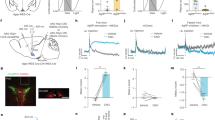Abstract
Hypothalamic growth hormone-releasing factors (GRFs) have been purified recently from human pancreatic (hp) tumours1,2 and from rat hypothalamus (rh)3. GRF peptides have strong homology with peptides of the glucagon, vasoactive intestinal polypeptide and PHI-27 family. Aside from their potent actions on release of somatotropin, no other biological actions of GRFs have been reported. GRF has been localized in neurones bordering the ventromedial hypothalamic nucleus (refs 4, 5; L. Swanson and P. Sawchenko, manuscript in preparation), a region associated frequently with experimental analysis of feeding behaviour6. We now report that intracerebroventricularly (i.c.v.)-administered rhGRF and hpGRF(1–40) in doses of 0.2, 2.0 and 20.0 pmol, produced an increase in food intake in hungry rats. This effect seemed to be specific to GRF as i.c.v. injections of a structurally related but physiologically inactive peptide7 in the same doses had no effect on feeding. In addition, peripheral injections of rhGRF or growth hormone had no effect on food intake, suggesting that the present effects may be mediated centrally. Injections (i.c.v.) of rhGRF (0.2, 2.0 and 20.0 pmol) had no effect on general activity, suggesting that GRF does not produce nonspecific arousal.
This is a preview of subscription content, access via your institution
Access options
Subscribe to this journal
Receive 51 print issues and online access
$199.00 per year
only $3.90 per issue
Buy this article
- Purchase on Springer Link
- Instant access to full article PDF
Prices may be subject to local taxes which are calculated during checkout
Similar content being viewed by others
References
Rivier, J., Spiess, J., Thorner, M. & Vale, W. Nature 300, 276–278 (1982).
Guillemin, R. et al. Science 218, 585–587 (1982).
Speiss, J., Rivier, J. & Vale, W. Nature 303, 532–535 (1983).
Bloch, B., Gaillard, R. C. Brazeau, P., Lin, M. D. & Ling, N. Regulatory Peptides 8, 21–31 (1984).
Bloch, B. et al. Nature 263, 251–257 (1983).
Carlson, N. R. in Physiology and Behavior, 355–363 (Allyn & Bacon, Boston, 1977).
Rivier, J., Spiess, J. & Vale, W. in Proc. 8th Am. Peptide Symp. (eds Hruby, V. J. & Rich, D. D.) 853–856 (Pierce Chemical Co., Rockford, 1983).
Pellegrino, L. J., Pellegrino, A. S. & Cushman, A. J. A Stereotaxic Atlas of the Rat Brain (Plenum, New York, 1979).
Joyce, E. M. & Koob, G. F. Psychopharmacology 73, 311–313 (1981).
Lee, J. & Laycock, J. Essential Endocrinology (Oxford University Press, 1978).
Moss, R. L. & McCann, S. M. Science 181, 177–179 (1973).
Author information
Authors and Affiliations
Rights and permissions
About this article
Cite this article
Vaccarino, F., Bloom, F., Rivier, J. et al. Stimulation of food intake in rats by centrally administered hypothalamic growth hormone-releasing factor. Nature 314, 167–168 (1985). https://doi.org/10.1038/314167a0
Received:
Accepted:
Issue Date:
DOI: https://doi.org/10.1038/314167a0
This article is cited by
-
Localization and function of neurosecretory protein GM, a novel small secretory protein, in the chicken hypothalamus
Scientific Reports (2018)
-
Appetite regulation: The role of peptides and hormones
Journal of Endocrinological Investigation (1989)
-
Growth hormone releasing factor and somatostatin concentrations in the milk of lactating women
European Journal of Pediatrics (1988)
Comments
By submitting a comment you agree to abide by our Terms and Community Guidelines. If you find something abusive or that does not comply with our terms or guidelines please flag it as inappropriate.



